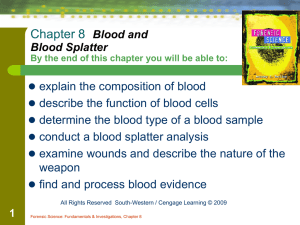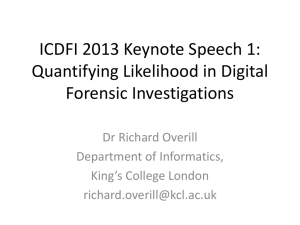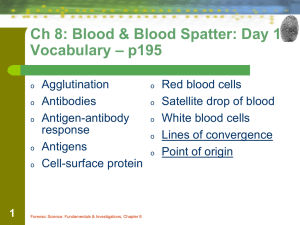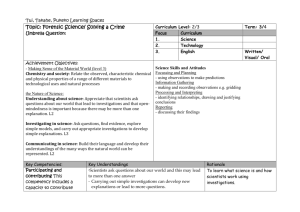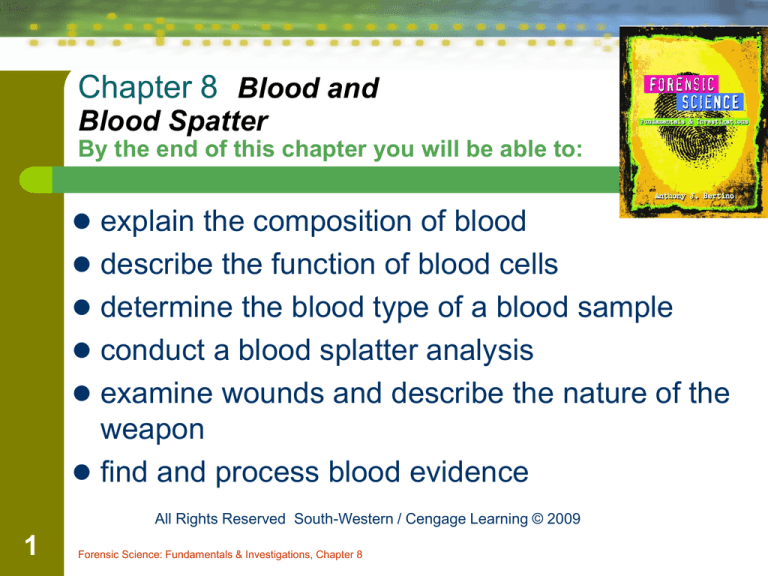
Chapter 8 Blood and
Blood Spatter
By the end of this chapter you will be able to:
explain the composition of blood
describe the function of blood cells
determine the blood type of a blood sample
conduct a blood splatter analysis
examine wounds and describe the nature of the
weapon
find and process blood evidence
All Rights Reserved South-Western / Cengage Learning © 2009
1
Forensic Science: Fundamentals & Investigations, Chapter 8
Composition of Blood
Whole blood
– carries cells and plasma—the fluid with hormones, clotting
factors, and nutrients.
Red blood cells (Erythrocytes)
– contain hemoglobin which carry oxygen to the body’s cells
and carbon dioxide away
– most abundant cells in our blood
– produced in the bone marrow
2
Forensic Science: Fundamentals & Investigations, Chapter 8
Composition of Blood
White blood cells (Leukocytes)
fight disease and foreign invaders
– contain cell nuclei
– produce Antibodies
–
3
proteins secreted by white blood cells that attach to
antigens to destroy them
Forensic Science: Fundamentals & Investigations, Chapter 8
Composition of Blood
Platelets (Thrombocytes)
–
–
–
4
aid in blood clotting and the repair of damaged
blood vessels
clot together in a process called coagulation to
seal a wound
clotting factors that are carried in the plasma
Forensic Science: Fundamentals & Investigations, Chapter 8
Composition of Blood
Plasma
–
–
–
5
yellowish liquid portion of blood
contains electrolytes, nutrients and vitamins,
hormones, clotting factors
Also contains proteins such as antibodies to fight
infection
Forensic Science: Fundamentals & Investigations, Chapter 8
Blood Facts
6
An average adult has about FIVE liters of blood
inside of their body (7-8% of body weight).
There are about one billion red blood cells in two
to three drops of blood.
For every 600 red blood cells, there are about 40
platelets and one white cell.
Forensic Science: Fundamentals & Investigations, Chapter 8
Blood Typing
Blood type is established before you are BORN,
by specific GENES inherited from your parents.
–
7
Yes 1 from Mom and 1 from Dad
The genes determine your blood type by causing
proteins called AGGLUTINOGENS to exist on
the surface of all of your red blood cells.
Forensic Science: Fundamentals & Investigations, Chapter 8
Blood Typing
Three alleles for blood type: A,B,O
–
–
–
8
That means 6 combinations
Blood Types
AA or AO = Type A
BB or BO = Type B
OO = Type O
AB = Type AB
Forensic Science: Fundamentals & Investigations, Chapter 8
http://learn.genetics.utah.edu/units/basics/blood/
types.cfm
Blood Typing—Proteins
42%
12%
3%
of the population in the United States
(of which 85% is Rh+)
43%
Blood typing is quicker and less expensive than
DNA profiling.
It produces class evidence but can still link a
suspect to a crime scene or exclude a suspect.
9
Forensic Science: Fundamentals & Investigations, Chapter 8
Rh Factor
10
While studying Rhesus monkeys (often studied
due to similarities with humans), a certain blood
protein was discovered.
The presence of the protein, or lack of it, is
referred to as the Rh (for Rhesus) factor.
Blood contains the protein= Rh positive (Rh+).
Blood does not contain the protein= Rh negative
(Rh-).
Forensic Science: Fundamentals & Investigations, Chapter 8
Blood Typing— Proteins and Enzymes
Antigens
–
foreign molecules or cells that react to antibodies
Enzymes
–
–
11
complex proteins that catalyze different biochemical
reactions.
Many enzymes and proteins have been found in the
blood that are important for identification purposes.
Forensic Science: Fundamentals & Investigations, Chapter 8
Blood Typing—Probability and
Blood Types
Given the frequency of different genes within a
population, it is possible to determine the
probability that a particular blood type will appear
in a particular population.
To determine the probability of two separate
events, it is necessary to multiply their individual
probabilities.
By identifying the additional proteins in the blood
evidence sample, investigators can limit the size of
a suspect population and help identify a suspect.
12
Forensic Science: Fundamentals & Investigations, Chapter 8
Blood Typing
46.1%
38.8%
11.1%
3.9%
13
Forensic Science: Fundamentals & Investigations, Chapter 8
Blood as Evidence
Blood typing = class evidence
DNA profiling = individual evidence
Blood splatter pattern
–
–
14
used to verify an account by a witness or a suspect
the origin of the blood, the angle and velocity of
impact, and type of weapon used.
Forensic Science: Fundamentals & Investigations, Chapter 8
Human versus Animal Blood
Microscopic observation
Precipitin test—blood is injected into a rabbit;
antibodies are formed; the rabbit’s blood is extracted
as an antiserum; the antiserum is placed on sample
blood. The sample will react with human proteins if
human blood is present. This test is very sensitive
and requires only a small amount of blood.
Animal Blood
Larger nucleic red blood
cells
Frog blood
Human Blood
Human red blood cells no not
have a nucleus.
Red blood cells are most
numerous; 5 to 6 million per
mm3
White blood cells are larger and
less numerous; 5,000 to
10,000 per mm3
Platelets are tiny, cellular
fragments; 350,000 to
500,000 per mm3
Blood as Evidence
18
Blood samples – Can be analyzed to determine
blood type and DNA, which can be matched to
possible suspects.
Blood droplets – Can be analyzed to give clues
to the location of a crime, movement of a victim,
and type of weapon.
Blood spatter – Can be analyzed to determine
patterns that give investigators clues to how a
crime might have happened.
Forensic Science: Fundamentals & Investigations, Chapter 8
Blood Spatter
19
In 1939 the meaning of the splatter pattern was
first analyzed.
When a wound is inflicted, a blood splatter
pattern may be created.
It takes a grouping of blood stains to make a
blood splatter pattern.
The pattern can help to reconstruct the events
surrounding a shooting, stabbing, or beating.
Forensic Science: Fundamentals & Investigations, Chapter 8
Blood Spatter Analysis
Analysis of a splatter pattern can aid in
determining the:
– direction blood traveled.
– angle of impact.
– point of origin of the blood.
– velocity of the blood.
– manner of death.
20
Forensic Science: Fundamentals & Investigations, Chapter 8
Blood Spatter
Analysis
When blood falls from a height or at a high
velocity, it can overcome its natural
cohesiveness and form satellite droplets.
When it falls onto a less-than-smooth
surface, it can form spiking patterns around
the drops.
21
Forensic Science: Fundamentals & Investigations, Chapter 8
Blood Splatter Analysis—Six
Patterns
Describe each of these:
a. passive drops
b. arterial gushes
c. splashes
d. smears
e. trails
f. pools
22
Forensic Science: Fundamentals & Investigations, Chapter 8
Blood Splatter Analysis—Impact
Patterns can help investigators determine the
type of weapon used.
23
–
What kind of a pattern is produced by a gun
shot?
–
What kind of a pattern is produced by a
hammer blow?
Forensic Science: Fundamentals & Investigations, Chapter 8
Blood Splatter Analysis—
Directionality
The shape of an individual drop of blood
provides clues to the direction from where
the blood originated.
How will the point of impact compare
with the rest of a blood pattern?
24
Forensic Science: Fundamentals & Investigations, Chapter 8
Blood Splatter
Analysis—Location of the Origin of the
Blood
25
Lines of convergence
Draw straight lines down the axis of the
blood splatters.
Where the lines converge, the blood
originated.
Forensic Science: Fundamentals & Investigations, Chapter 8
Crime Scene Investigation
of Blood
Search for blood evidence.
2. If any is discovered, process it determining:
a. Whether the evidence is blood.
b. Whether the blood is human.
c. The blood type.
3. Interpret the findings:
a. See if the blood type matches a suspect.
b. If it does not, exclude that suspect.
c. If it does, decide if DNA profiling is needed.
1.
26
Forensic Science: Fundamentals & Investigations, Chapter 8
. . . . . . . . . . . . . . . . . Summary
Blood consists of cellular components and plasma.
The various human blood types are caused by the
presence or absence of A or B or both A and B
proteins on the surface of red blood cells.
Blood splatter evidence can be used to recreate a
crime scene.
Investigators endeavor to (a) locate, (b) identify,
and (c) interpret blood splatter patterns at crime
scenes.
27
Forensic Science: Fundamentals & Investigations, Chapter 8

